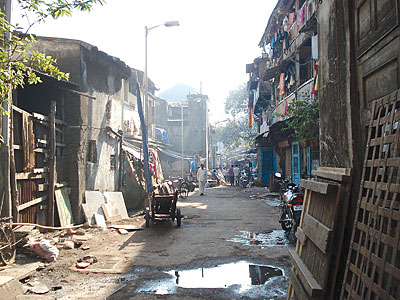 FAR FROM HOME: A daylight view of Mumbai's notorious red-light district, Kamathipura |
MUMBAI � If you say the word 'Kamathipura' in public here, you will immediately get a wide-eyed stare from your Indian friends, followed by a desperate "shhh!" as they look around to see who heard you utter the dirty word. It is a dirty word � and also the name of the city's most shameful place � and it remains so because nobody wants to talk about it and nobody wants to think about it.
Kamathipura is a compact grid of lanes and alleys filled with buildings containing brothels on top of brothels. During British rule, the area was an upper class red-light district. It has since devolved into a den of overcrowded shanties and unmaintained buildings full of girls from nearly every South Asian country. A few specific lanes house the highly desired but relatively cheap fair-skinned girls from Nepal.
International filmmakers, journalists, and photographers flock to Mumbai to write stories or make documentaries on Kamathipura. But though the city is the country's largest hub for media and film, foreigners who seek to cover sex slavery rarely have the support of local professionals. Far from it. Many Mumbaikaars view foreign interest in the thriving sex trade as a conspiracy to perpetuate a false image of India as an undeveloped Third World country. But they fail to understand that global media interest in Kamathipura does not stem from a desire to prove India's lack of development, but rather from wanting to shed light on one of the world's largest human rights violations � the kidnapping and daily rapes of tens of thousands of girls.
Michelle Obama wanted to visit Kamathipura on her recent trip to Mumbai, but the government of Maharashtra refused to grant permission. It would have been impossible to secure the area to ensure her safety, it's true. But more than that Mumbai, boasting the bulk of India's wealth and development, did not want to expose the First Lady of the United States to the sad reality that teh city has failed to intervene to uphold the basic rights of young girls.
Many people say the root cause of trafficking is poverty. While poverty is certainly a factor, it is not the root cause; if it were, then tens of thousands of boys would be locked up in slavery. The root cause of trafficking is that even today, in 2010, women and girls are perceived as disposable commodities.
In Nepal, girls who are sent away are described as "girls who have gone to Mumbai to work", whereas in Mumbai, they are merely prostitutes. The failure to identify these girls as what they are � victims of kidnapping, rape, and slavery � allows both sides to get away with not acknowledging the urgency of the cause and from taking responsibility for the crime. The root cause of trafficking is that nobody fights fiercely for a girl's life.
Experts estimate that each girl in Kamathipura is worth around US$250,000 to her owner. The sex trade is not only about poverty; it is also about power and money. The underworld is intricately connected to the above-ground world; politics, building, business, and Bollywood have financial ties that can be traced to the black money made from the plight of Nepali girls in bondage. This makes the stakes too high and the trade-offs too low for most people to truly become involved in fighting trafficking.
The only possible protection for Nepali girls at risk of kidnapping, daily rape, incarceration, and ultimately death from AIDS, is Nepal, the Nepali government and the Nepali people. The 1751-km border between India and Nepal needs to be secured, villagers need to be informed about the reality of 'jobs' abroad, equal numbers of boys and girls need to be educated, and men and women need to recognise the value of a woman to her family, village and country. The number of girls sold into sex slavery is increasing every year, and given the current political and economic instability of the country, it is critical to build up a healthy, sustainable Nepali society, rather than eroding future potential in the pursuit of instant gratification.
READ ALSO:
Nepal's Hero


